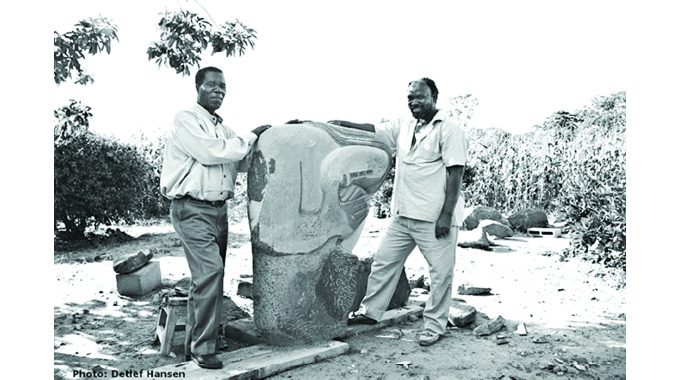
Suburban

The late Nicholas Mukomberanwa was born in the Buhera district of Zimbabwe in Manicaland Province in 1940.
His childhood was spent in a rural environment which was fundamentally to influence his later life and work (“a wonderful place to grow up – surrounded by mountains and rivers with places full of trees”).
It was at the Serima Mission School where he was introduced to the discipline of wood-carving as well as the images of formal worship (Christian) and those of traditional African art.
Nicholas, in most of his lifetime, acknowledged the importance of this initial influence (“the seed of art was sown in my heart”), but whereas Serima had provided a rigid and secure framework in which to make early explorations into artistic realms, the very particular philosophy followed by Frank McEwen (whom he met in 1962) hung upon a belief in allowing the natural, latent talents within the artist to emerge, with little formal guidance and ‘training’. This one element alone seems, in retrospect, the most important in the refinement of Nicholas’ ideas and ambitions.
While still working in full-time employment (as a policeman) Nicholas began to carve. He had now found his natural area of expression and his work was soon included in important exhibitions internationally — to considerable acclaim.
Rather than allowing this early success to influence his development, Nicholas remained aloof, choosing to question himself rigorously; “I wanted to learn more to help me to resolve problems; there was always a question mark in my head — why is it good — why is it bad?”
This is an attitude that guided the talented sculptor throughout his life and career.
“There is one thing in my life that determines all else. I want to be a great artist — I want to work so I can express what I feel and think truly myself in my own way.”
A constant searching for new forms of description resulted in some quite fundamental changes in direction within the work.
In the very beginning his portrayal of West African images as well as scenes from the Bible were rounded and very simple. Work from the 1960s showed a much more stylised, patterned use of geometric as well as clear, curvaceous forms (the “feeling” behind these works, as opposed to any formal type of influence, has been described by Frank McEwen as “ancient near Eastern”).
During the 1970s, using the hard, black Penhalonga Serpentine, the work became characterised by the confident use of sharp lines and planes, and of ambitiously abstracted form. Some of his most powerful sculpture was made in the 1980s and seem to combine elements of earlier discovery — nothing was wasted. Sharp lines and hard planes were used with confidence alongside sweeping curves and deeply etched surfaces. The aspect that so distinguishes this period of work was an absence of doubt and a conviction that can only come from genuine investigation and a courageous search, both of the internal spirit and of the natural physical world.
He was both knowledgeable and proud of the Shona culture — it provided powerful motivation for his work and seemed to demand that he strived towards the preservation as well as the portrayal of it in his sculpture.
Nicholas, who died in 2002, is considered to be one of Zimbabwe’s most gifted and successful sculptors and is highly regarded internationally. His work can be seen in the permanent collections of many international museums.
His sculptures showcased human forms at various levels of abstraction and sometimes depicted animals, birds, or spiritual feelings . He primarily worked with hard stone, using local materials such as opal stone, cobalt stone, and a local variant called springstone found at Tengenenge . His sculptures were often highly polished, although he would sometimes contrast smooth sections with areas of great roughness .
Nicholas’ work demonstrated a sense of increasing spiritual support that sustained his art over the years. He spoke from personal experience rather than recounting what he had heard or been told, and his beliefs were personally held rather than customarily observed. His sculptures have been exhibited in galleries around the world, and he remains one of Zimbabwe’s most celebrated sculptors .
Nicholas began his sculpting career in 1962 when he met McEwen, the Director of the National Gallery of Zimbabwe, who was impressed with his early work and encouraged him to sculpt full time.
He became an early member of the workshop school at the National Gallery and played a significant role in the Zimbabwean sculpture movement. Mukomberanwa’s influence on the movement was immense, and he mentored and taught many artists, including his own family members who are also sculptors .
His son, Tendai Mukomberanwa, followed in his footsteps. Tendai began sculpting from a young age under the training of his father and has continued to create artwork that has been sold and exhibited worldwide.
Overall, Nicholas’ sculpting legacy is characterised by his unique style, use of local materials, and his personal and spiritual approach to his art. His contributions to the Zimbabwean sculpture movement and his influence on other artists, including his own family members, have solidified his place as one of Zimbabwe’s most celebrated sculptors. — zimsculpt.com



